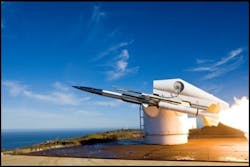Northrop Grumman to build 16 supersonic target drones to train ship crews to counter anti-ship missiles
PATUXENT RIVER NAS, Md. – Aerial target experts at Northrop Grumman Corp. are building supersonic target drones for the U.S. Navy to help surface warship crews practice how to detect and defeat incoming supersonic anti-ship missiles.
Officials of the Naval Air Systems Command at Patuxent River Naval Air Station, Md., announced a $52.1 million order Monday to the Northrop Grumman Launch Vehicles and Propulsion segment in Chandler, Ariz., to build 16 GQM-163A lot 17 full-rate-production Coyote supersonic sea skimming target base vehicles for the Navy.
The GQM-163A Coyote supersonic sea skimming target is designed to provide an affordable target to simulate supersonic sea-skimming and other emerging supersonic and hypersonic anti-ship cruise missiles. It also supports research in ship-defense systems and fleet training.
The supersonic target drone is designed to help Navy ship crews learn to defend themselves against modern anti-ship missiles like the French Exocet and the Russian-made SS-N-22 Sunburn and SS-NX-26 Oniks, which may be operational with military forces in Iran, Syria, and other countries in the Middle East for use against U.S. and allied naval forces in and around the Eastern Mediterranean, Persian Gulf, and other vital waterways.
The Sunburn anti-ship missile can fly at three times the speed of sound, giving targeted vessels little time to react. It carries a 705-pound explosive warhead -- twice the destructive payload of the Exocet and three times as fast.
The Oniks missile, more advanced than the Sunburn, can fly as fast as Mach 2.5, and carries a 661-pound warhead. Not only is this missile far faster and more powerful than the Exocet, but it may have the capability to maneuver on its terminal flight to its target, which could make defeating it difficult, if not impossible.
The Sunburn and Oniks missiles have sufficient destructive payloads to pose serious threats to large U.S. warships like aircraft carriers, which are at the heart of U.S. power-projection strategies around the world.
GQM-163A Coyote supersonic sea skimming target is a non-recoverable, supersonic aerial target, capable of speeds of Mach 2 or greater and altitudes from 13 to 66 feet above the surface of the ocean, Northrop Grumman officials say.
Northrop Grumman won a contract to develop the GQM-163A in 2000, and the target drone has been operational since 2005. In October 2014 the company won a $27.7 million Navy contract to build eight GQM-163A practice missiles.
The GQM-163A drone is designed to simulate sea-skimming cruise missiles by flying faster than twice the speed of sound as low as 12 feet off the surface of the ocean. The target drone also can simulate high-altitude cruise missile attacks that plunge down at ships from higher than 30,000 feet.
On this contract Northrop Grumman will do the work in Chandler, Ariz; Camden, Ark.; Vergennes, Vt.; Cincinnati; Oconomowoc, Wis,; Lancaster, Pa.; and other U.S. locations, and should be finished by November 2027.
For more information contact Northrop Grumman Launch Vehicles and Propulsion online at www.northropgrumman.com/space/interceptors-and-targets, or Naval Air Systems Command at www.navair.navy.mil.

John Keller | Editor-in-Chief
John Keller is the Editor-in-Chief, Military & Aerospace Electronics Magazine--provides extensive coverage and analysis of enabling electronics and optoelectronic technologies in military, space and commercial aviation applications. John has been a member of the Military & Aerospace Electronics staff since 1989 and chief editor since 1995.

